The dilemma of a rabbit with a broken leg
 Jack was found as a stray and taken to a rescue centre who brought him for veterinary treatment. The rabbit was not neutered. He looked young (less than a year old) and was thin with some infected bite wounds over his back and neck. He was also lame on his left hind leg. There was marked muscle wastage on the lame leg, heo the injury was not new. It was difficult to examine Jack's leg properly during the consultation so he was admitted to be anaesthetised, castrated and investigate his lameness.
Jack was found as a stray and taken to a rescue centre who brought him for veterinary treatment. The rabbit was not neutered. He looked young (less than a year old) and was thin with some infected bite wounds over his back and neck. He was also lame on his left hind leg. There was marked muscle wastage on the lame leg, heo the injury was not new. It was difficult to examine Jack's leg properly during the consultation so he was admitted to be anaesthetised, castrated and investigate his lameness.
In general, lame rabbits are always a problem. Rabbit bones are brittle and shatter easily so fractures can be complex and difficult to repair. Orthopaedic surgery is expensive and infection is a potential complication that can be difficult to control especially if the fracture is a compound (or open) where a piece of broken bone has punctured the skin. This quickly allows infection to gain access to the bone and the tissues under the skin. In general, fractures of the forelegs are easier to repair than the hindlegs because they are easier to immobilise with a splint or support bandage. The hindlegs are more difficult because of their length, shape and strength. It is difficult or impossible to apply a comfortable splint or bandage, which is why they require surgery to repair a fracture with pins, wires, plates, external fixation or a combination of techniques. After surgery, the leg needs to be rested - one thump can undo a lot of hard work. If the fracture is below the hock, bandages or splints easily become contaminated with urine and/or faeces and a high standard of post-operative nursing is required. The whole procedure can prove expensive, maybe more than £1000. Amputation might seem like an easier and cheaper option but it is irreversible and leaves the rabbit with a permanent disability, especially if it is a hindleg that is removed. A small study of the outcome of amputation has been published and the conclusions are similar to my own experiences.
For a rescue centre, finding a new home for a lame rabbit can be a problem, so, in this case, the obvious solution for Jack was for me to adopt him so I could treat his leg. Dutch rabbits are favourites with me. I like their upright ears and normal shaped faces.
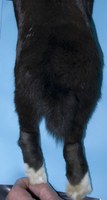
Under anaesthetic, I compared the length of Jack's legs by stretching them and found that the lame left leg was much shorter than the right one (see left). This is often associated with a dislocated hip so I positioned him on his back and took the radiograph (in box on left) expecting to find an old dislocation of the hip joint, which would explain his lameness. I was wrong. Both hips looked normal. I could see no abnormality in his stifles (knees) or pelvis.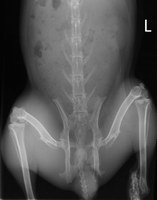
The reason for Jack's lameness can be seen on the lower right corner of the radiograph. It shows that the left hock is fractured. When it was manipulated, the hock was unstable and lax. Luckily there was no heat, puncture marks or signs of infection. Neither hock showed any evidence of a pressure sore, which was probably because Jack was thin and despite his disability, very active.
More X-rays were taken that are shown below
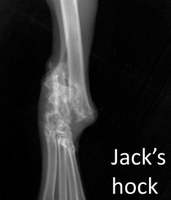
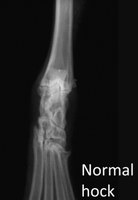
These X- rays show an old fracture/dislocation of the hock. It would have been a challenge to repair even if Jack had been seen when the injury occurred. It must have been painful when it happened. If he had been seen by a vet, amputation might have been considered as an option.
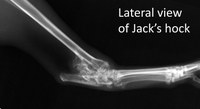
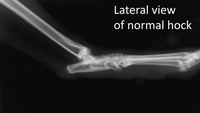
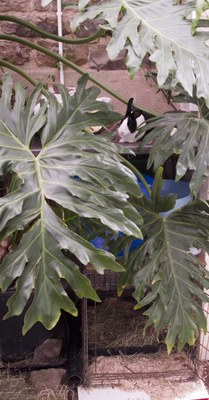
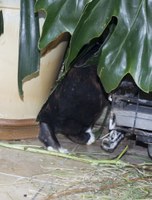 As Jack's injury was old (probably several months), and he did not appear to be concerned about it, I decided against surgery and gave him 7 day course of meloxicam instead. Jack was introduced to his new friends in my conservatory and was (and still is) very active on his injured leg. The video shows how well he can weight bear on his fractured hock, although the photo of his back view (left) as he squeezes past a plant pot and shows how lax his hock really is. Despite his disability, Jack can still jump. The picture on the right shows him sitting on a work surface that is is about 4 feet from the ground. He had jumped on to the top of the empty cage to get there.
As Jack's injury was old (probably several months), and he did not appear to be concerned about it, I decided against surgery and gave him 7 day course of meloxicam instead. Jack was introduced to his new friends in my conservatory and was (and still is) very active on his injured leg. The video shows how well he can weight bear on his fractured hock, although the photo of his back view (left) as he squeezes past a plant pot and shows how lax his hock really is. Despite his disability, Jack can still jump. The picture on the right shows him sitting on a work surface that is is about 4 feet from the ground. He had jumped on to the top of the empty cage to get there.
Jack's case illustrates how difficult it can be to decide what to do with a rabbit with a serious leg injury. If I had seen him when the injury occurred, I would probably have opted for surgery because I would have wanted the leg to be restored to normal. However, the surgery would have been complicated. The fracture involved the joint, which was also dislocated, which is why the lame left leg is shorter than the right one. There would have been no guarantee the surgery would have gone well without any complications and there is a possibility that it might have made things worse if infection had gained access to the surgical site post-operatively. I wouldn't have been comfortable with the idea of doing nothing and I wouldn't have considered amputation. For me, the reasons to remove a leg are:
- Severe trauma
- Loss of blood supply to the lower part of the limb
- Intractable infection
- Nerve damage and paralysis of the leg so that it is continually traumatised
- Congenital or acquired deformity that can't be corrected and is causing pain
- Neoplasia (cancer)
Jack didn't fit into any of these categories, which is why I would have opted for surgery. It could have resulted in a leg that was fully functional. As it is, the choice was made for me and Jack had no surgery. He will always be lame but he has shown that surgery or amputation are not the only options for a difficult fracture. There is a compromise. In selected cases, cage rest, painkillers and no surgery can result in a rabbit that may be disabled but does have the benefit of four legs to move around on. Jack is an example of how well these cases can do. Six months later, he is agile and almost impossible to catch. It is hard to believe he has such a bad fracture.
